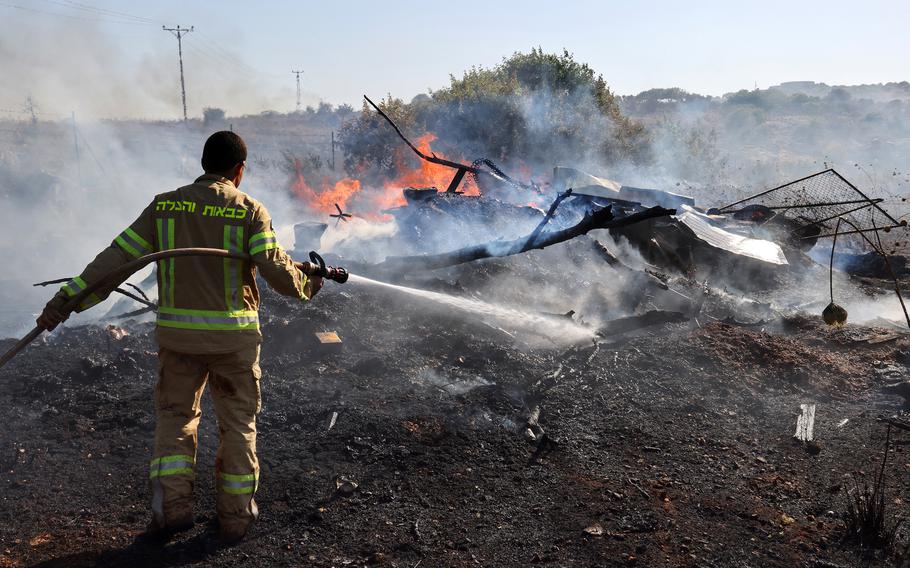
An Israeli firefighter puts out flames in a field after rockets launched from southern Lebanon landed on the outskirts of Kiryat Shmona, on June 4, 2024. Since the outbreak of war between the Palestinian militant group Hamas and Israel on October 7, the Lebanese-Israeli border area has witnessed near-daily exchanges of fire, mainly between the Israeli army and Hamas ally Hezbollah. (Jack Guez/AFP/Getty Images/TNS)
(Tribune News Service) — Israel is escalating warnings against Hezbollah in Lebanon by threatening it could be forced into a war with the Iran-backed group following increasingly deadly attacks.
Hezbollah’s rockets and drones have caused significant damage in the past few days, prompting Israeli officials to reiterate previous warnings to the group and Lebanon that war is an option. A drone strike on a military facility that went undetected on Wednesday wounded 10 Israelis and killed one soldier.
Prime Minister Benjamin Netanyahu on Wednesday visited the northern town of Kiryat Shmona, where Hezbollah’s Katyusha rockets caused an unusually massive blaze in a forested area.
“Whoever thinks he can hurt us while we respond by sitting on our hands is making a big mistake,” said Netanyahu. “One way or another, we will restore security to the north.”
Hezbollah and Israel have been trading fire across the border since Oct. 8, a day after Hamas militants, also backed by Iran and designated as terrorists by the U.S. and European Union, infiltrated Israel and killed 1,200 and kidnapped 250.
Israel has retaliated with a massive bombing campaign on Gaza and followed it with an invasion of the Palestinian strip, killing nearly 36,000 people, according to health officials in the Hamas-run enclave.
Israel Defense Forces Chief of Staff Herzi Halevi said this week that his country was approaching the point where a decision would have to be made on how to manage its northern front with Lebanon and that “the IDF is prepared and ready to move to an offensive.”
Israel’s military said on Sunday that it had completed an exercise to increase its readiness in areas bordering Lebanon and Syria, which included “scenarios simulating an expanded war in the northern arena, as well as multi-arena warfare.”
War cabinet member Benny Gantz, who’s been demanding that security be restored in the region by Sept. 1, said Wednesday that Israel “can’t lose another year in the north.” Gantz has given Netanyahu an ultimatum — which expires on Saturday — over the situation and called on the prime minister to present a plan for postwar Gaza.
On Wednesday, President Isaac Herzog said, “The world needs to wake up and realize that Israel has no choice but to protect its citizens and it should come as no surprise when it does so — strongly and ever more resolutely.”
“Do not be up in arms when the situation becomes out of control,” he said.
While the exchange of fire has been broadly limited to south Lebanon and Israel’s northern region, the attacks in recent days have caused alarm that the situation could spiral out of control.
Over the past four months, there’s been a more than 12-fold jump in the number of drone attacks by Hezbollah, which are more accurate and lethal and much harder to detect, trace and intercept.
Strikes using unmanned aerial vehicles more than doubled to 85 in May from April, with a comparable increase seen in the number of anti-tank missiles fired on Israeli territory, according to data from the Alma Research and Education Center. In total, attacks in May went up to 325 from 238 in the previous month.
Israel’s airstrikes on south Lebanon have caused extensive damage, leaving some villages almost entirely under the rubble and turning many others into ghost towns.
Some 60,000 Israeli residents of settlements adjacent to the border were evacuated from their homes by the government since Oct. 7 and some 90,000 civilians have fled south Lebanon.
Diplomatic efforts have so far failed to reach a compromise on ceasing the hostilities. While Israel is demanding Hezbollah withdraw about 6.2 miles away from the border, the group has publicly said that it wouldn’t negotiate any terms without a cease-fire in Gaza.
The Biden administration has tried to mediate a resolution by sending U.S. envoy Amos Hochstein on visits both to Beirut and Tel Aviv several times since the war in Gaza began. Hochstein has led negotiations in 2022 and resolved the maritime dispute between the two in what was a rare diplomatic success.
Naim Qassem, Hezbollah’s deputy secretary general, told Al Jazeera in an interview this week that if Israel “wants to go for an expanded war, we are ready for it.”
“We don’t want it but we are ready for it,” he said.
©2024 Bloomberg L.P.
Visit bloomberg.com.
Distributed by Tribune Content Agency, LLC.